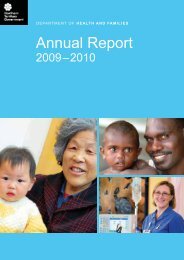PCD Strategy Evaluation 2007.pdf - NT Health Digital Library ...
PCD Strategy Evaluation 2007.pdf - NT Health Digital Library ...
PCD Strategy Evaluation 2007.pdf - NT Health Digital Library ...
Create successful ePaper yourself
Turn your PDF publications into a flip-book with our unique Google optimized e-Paper software.
the establishment of the Sunrise <strong>Health</strong> Service in Katherine and the establishment of governingboards in the Primary <strong>Health</strong> Care Access Program (PHCAP) regions. Issues of Indigenousgovernance are paramount to addressing the underlying causes of chronic disease, and to tacklethe social determinants of health. Hence it is vital to ensure that strategies developed arerelevant and workable in the environment that will be applied.Assessment against <strong>NT</strong><strong>PCD</strong>S key result areasThere are six key result areas in the <strong>NT</strong><strong>PCD</strong>S where there is strong evidence to supportintervention. Between 1999-2002 in the Northern Territory there was a reduction in lowbirthweight in Indigenous and non-indigenous babies and an increase in the mean birthweight ofboth groups (3) . Breast feeding rates at discharge from hospital were unchanged from 1993-2003(3) , however breast feeding rates at 3 months and 6 months post birth fell between 1993-2003.This fall was largely due to a decrease in breast feeding rates in the urban non-Indigenouspopulation. By six months of age, the proportion of <strong>NT</strong> rural Indigenous infants who were stillbreastfed was above the national average (3) . The childhood immunisation coverage for the <strong>NT</strong>has improved significantly between 1999-2005, and data suggests that <strong>NT</strong> children haveimmunisation coverage that is as good as, or better, than the rest of Australia (3) . Timeliness ofvaccine delivery is reportedly still not optimal.Rates of malnutrition are measured by rates of stunting, wasting and anaemia, which between2001-05, have not changed. Overall Indigenous children in remote communities experience highlevels of underweight – 15 per cent, stunting – 11 per cent, and wasting – 9 per cent (3) .Anaemia rates of children under 5 years remain extremely high in remote areas ranging from 23per cent in the Darwin rural district to 44 per cent in the Barkley district. The proportion of <strong>NT</strong>urban children who are overweight lowered slightly at 12 per cent compared with SouthAustralian children at 14.4 per cent. The number of <strong>NT</strong> urban Indigenous children who are obeseis double the non-indigenous urban rate. The availability and cost of healthy food in remote areascontinues to be poor and extremely expensive despite several inquiries during this time. Theissue of poverty is critical to the success of improving all of these key indicators yet <strong>NT</strong>Indigenous households continue to receive only 59 per cent of non-indigenous households (5) .Results of the 2007 Indigenous Community Housing Survey reveal poor environmental healthconditions especially in discrete remote communities, where there continues to be a lack of basichousing maintenance, overcrowding, unsafe water supply, lack of rubbish disposal, and thehighest national sewerage overflow rate (6) .<strong>Evaluation</strong> of the <strong>NT</strong> Preventable Chronic Disease <strong>Strategy</strong> 2007xiii
















